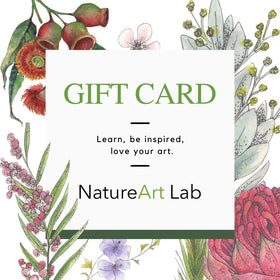
Fired Up About Mulligans Flat - by Fiona Boxall
It all started with a visit to Mulligans Flat as the temperature drifted gently towards 40 degrees C and the threat of bushfires simmered in the background. As a group we were a mix of both experienced artists and enthusiastic, but relative beginners. We were out there on this improbably hot day looking for botanical specimens to paint and preserve as part of one of NatureArt Lab’s many and varied workshops. Lugging water and block out, buckets and trowels, cameras, back packs and our good intentions, we were on a mission to find riches in what at first glance seemed to be not much more than some tussocks of kangaroo grass and a few stands of eucalypt.
Overlooked by a group of seemingly jaded kangaroos used to the peculiar behaviour of humans in the heat, we were being led by our intrepid guide ranger Rachel and renowned botanical artist Mali Moir to each find a treasure to paint from our approved list. This was far more than a grab and go expedition, the botanical equivalent of a late-night trip to the service station in search of a last-minute bunch of blue carnations. This was an induction into the process of collecting botanical specimens in a fragile environment, a lesson in respect and due process sandwiched between a hands-on art workshop experience that taught everyone there exciting new skills.
It was a whole lot of fun, too, with each of us getting to know our chosen plant inside and out, both as a botanical specimen and as a painting subject. What might initially have seemed little more than a tuft of kangaroo grass or an unassuming blue Wahlenbergia took on the fascination of the most exotic of species as we conducted research and spent several days trying to keep them alive and fresh.
To say I fell in love with my chosen specimen, a rapidly expiring stem of mistletoe, is an understatement. This most unassuming plant twig became the centre of my universe and some months on I will still happily swamp anyone who asks about it with more information than they ever expected or probably wanted on its mysteries and unexpected beauty.
The workshop brought together a group of people with diverse skills, life experiences and interests. There was a marine biologist, several scientists, stalwarts from the Wollongong Botanic Gardens florilegium project, teachers and myself, an almost retired journalist.
But I won’t lie and say I found this a relaxing way to spend a few days. It was hard work and I freely admit that at times I felt overwhelmed and out of my depths when confronted with the considerable talent and knowledge in the room. But I learnt so much and my skills progressed quite substantially. I also discovered so much more about the process of doing this kind of work, of what it takes to negotiate the understandably complex rules and regulations surrounding sensitive environmental areas and the collection of specimens. I thoroughly enjoyed the process of becoming what Julia refers to as a citizen scientist and developed a genuine respect for the dedication it takes to get projects like this one up and running. I became part of a project where an ordinary person like myself can make a positive contribution towards recognising the beauty and importance of protecting our environment.
Our tutor Mali was wonderful. Patient, generous and exacting, she dealt with our wildly varying skill sets to help us produce work we could be proud of. She was adept at recognising my growing sense of often not-so-quiet panic and helping to retrieve my work from the brink of extinction, just as she was still able to give those in the group with far more advanced skills guidance to help them produce what were simply beautiful images.
At the end of the workshop we were all pretty pooped but there was a definite sense of achievement in the room. The works varied in skill level and medium, ranging from coloured pencil through to pastels and watercolour, but each of them was beautiful and had been improved by Mali’s knowledge and patience. The supportive workshop experience gave us all the time and space to get to know our plant and recognise its unique value while becoming immersed in the project.
I can’t recommend highly enough the extended time a workshop like this gives you to immerse yourself in both the science and the practice of this type of art. It was hard work but it was fun and I think most of us attending came to feel we had experienced something pretty special. I will never look at a seemingly scrubby landscape like Mulligans Flat in the same way again. It is a wonder to be cherished, full of natural treasures to be looked after for the generations to come. And my love affair with that mistletoe continues.



Comments
Leave a comment